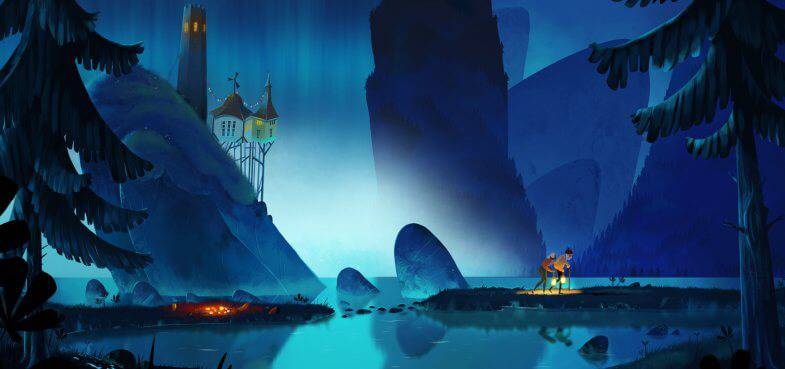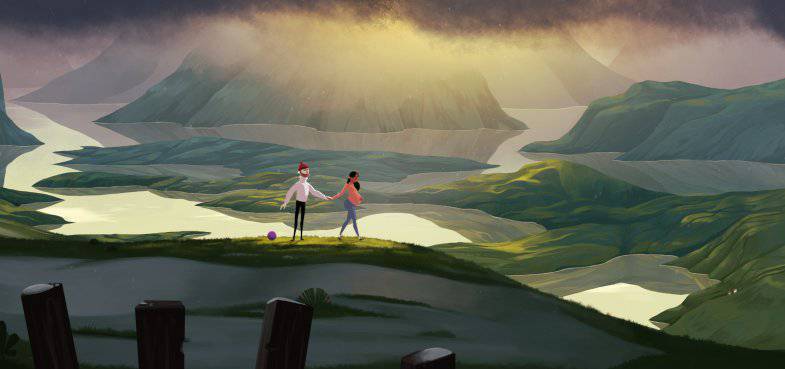Interview: Izzy Burton breaks down Blue Zoo’s new short – Via
Following on from their BAFTA nomination success, Blue Zoo has released their latest short film – Via. Via tells the story of life and the meaning of dreams and hopes, living experiences to the full and the people we surround ourselves with. Filled with breathtaking environments and expressive character animation, Blue Zoo’s adaptation of Rachel Cladingbowl’s poetry, truly is exquisite.
After studying at Bournemouth University, Izzy Burton joined Blue Zoo as a concept artist and has worked on everything from dancing naked Christmas elves to candy obsessed witches. With all this experience, it is demonstrably clear why Izzy was chosen to direct her own short through the company’s shorts program. Not only did Izzy direct this short, as a concept artist, she also created all the 2D digital environments for the 3D characters to interact with. We caught up with Izzy to learn more about her time at Blue Zoo and her development of her short film.
Can you explain how the film got started and how you were chosen to direct it?
I’d pitched for the shorts programme the two times it had come up since I’d been at Blue Zoo and hadn’t been successful, for a number of reasons but I felt like I’d been forcing ideas I already had to fit a brief rather than naturally forming ideas. So I approached Tom with the idea for my short, with the aim that I would try create it as much as possible on my own so that, unlike the shorts programme, I wouldn’t take up too much time elsewhere in the pipeline. It was a sort of under the radar project, that I just picked up every time I had a spare moment, it was nice because it challenged me to learn lots that I would usually ask a colleague to do or at least help with, and it’s why it took 18 months instead of our usual 4-6 months we have for shorts.
You were inspired by a lovely poem by Rachel Cladingbowl. How did you find out about that poem and what was it that touched you so much?
I’m not exactly sure what got me to the point of searching for poems, but I ended up on google looking for poems about life. I remember that I wasn’t really looking for a poem to be a narrative, like it ended up being, but more for inspiration to help guide the story I was forming. When I found Rachel’s poem on an online forum it just fit so perfectly with the storyline I had already come up with, that I had to use it – it felt like fate. I think that’s why it touched me so much, it was as if she’d written the words that accompanied the drawings I had done. I contacted Rachel by leaving a comment on her poem post and she emailed me saying it was absolutely fine to use the poem – she seems really chuffed with the finished film, so I’m really happy we did her poem justice!
And how did you script this? What was your process when translating her words into a visual story?
Because I’d already began forming the story, I just recorded myself reading the poem and started to cut it up and line it up with what I had. The poem was longer than what I had storyboarded, so I added in more scenes that created a stronger story and fitted with the poems progress. When we had the narration recorded properly by Harry I had to shift everything a little again because he had such a lovely slow voice, but by that time it was just a case of extending the scenes we already had. The rhythm of the poem helped the film flow better, it had more space to breathe.
You decided to have 3D characters interact in a 2D environment, what made you choose that style? And how did that affect your pipeline?
As I mentioned above, this project was going to be a one-woman show as much as possible but as the story got more and more elaborate, with the length and the additional characters, it made much more sense to have the characters in 3D so that they could be animated by the incredible animators we have in the studio. I’ve never animated a human in 2D, so it would of been a massive challenge and I would have struggled with the basics, let alone trying to get the acting and emotion right. I really believe the performance of the animation made the film, and that’s all credit to the animators. In terms of pipeline, it worked fine because I had most of the environments at least loosely drawn up, so the animators could use them to stage the animation.
The environments you created for this film are absolutely stunning! Can you talk a bit about how you developed those locations? Were they based on real places?
The first thing I did with this film, before it was even a full idea, was sketch out tiny thumbnails of landscapes. I just wanted to draw as many different types of landscapes as possible, so it looked like they had travelled far and also out of a selfish thought that I really wanted to try paint up a variety of things. The variety of environments has led everyone to believe they are in the USA and I spent 2 years of my childhood in America, so I’ve always had this weird internal pull towards it, I even still spell Mom with an ‘o’. I wanted them to be environments that were stylised but had some root in the real world. It was tricky to make sure they were coherent, as I drew the night background first with the lake, I then had to work out what sand and snow looked like in the style.I had to go back and change a lot of rocks because I’d drawn them one way, but when I came across a background with lots of rocks the detail I had given the rocks in previous shots was too much for the current shot. It was a back and forth, and there were some locations that just weren’t working even after I’d got to the final stage of animating all the tiny background pieces … so there were times when I just started over to get a better composition, colour and feel. I’m really glad I didn’t just settle for any of the backgrounds, I really questioned them all throughout; at some points to the extreme where I was asking myself was the film going to be any good at all?
Is the film set in any particular period? It seems almost post-apocalyptic.
The post-apocalyptic feel was a subconscious choice. I love overgrown, abandoned places and just old things in general. I know that probably sounds odd, but I love collecting old books (especially if they have inscriptions in the covers) and old postcards because I love the idea that they hold so much history and story, and it’s an insight into another time. And I’m kind of the same with abandoned houses and these pockets of forgotten places that hold so much story, I really love that. The short draws inspiration from my favourite film, Interstellar, and other post-apocalyptic films like Wall-E, and artists like Shaun Tan, who depicts beautiful, parallel or futuristic societies and worlds. They all share that abandoned, empty world feel and I love that, and I think it cemented one of the things I wanted to show in the film, that people should focus on what matters and not be distracted by the stress of the everyday, but that behind your own story there are all these other stories and histories that intertwine.
What elements were most challenging when you were making this film?
One of the most challenging things was the boundaries of my knowledge and skill level, and I had to learn things as I went. But it was great fun experimenting with After Effects and I’ve learnt a lot from doing the project.
But easily the hardest thing was the ending. I’m not joking when I say I storyboarded and thought of at least 20 variations of the ending. I wanted to show that by retracing his footsteps and thinking about his life he had realised that even though he was now without some of the most important things, he could appreciate that his life had been this fantastic journey, ups and downs and all. I wanted it to be happy, but more of a content happy. And originally I had him smiling at the end, but it didn’t work with the simple characters who had no faces. So I had to rethink it. I hoped that him with the ball at the end, back at his childhood home, taking in the sunset, was a good way to show this. I liked the idea that the ball had been brought back to his house by his son, and perhaps his son’s family, and that at any moment his grandson might appear just like he appeared to his grandfather in the first shot and the whole thing would be repeated. The cycle of life.
I feel like still the ending isn’t exactly right, but I think that may be because the short doesn’t end with his life ending: the story isn’t finished. He’s telling us up to now, and there’s still more to come, therefore it’s not really the end at all.
The voiceover in this is quite moving, what was your casting process like? Why did you go specifically for that style and was it hard to find someone who fit what you were looking for?
I never realised how hard it would be to find an old voice. Even the older generation of voice actors don’t have that audible raspiness that I wanted. I listened to so many old voices, and narrowed it down to those with raspy, characterful, warm, grandfatherly voices and then realised that I didn’t like the posh english voices and I didn’t like the cockney accents, but I loved the American accent. And it really cemented the fact that this was going to be america, and Tom agreed that Harry’s voice was the warmest, most grandfatherly voice. He’s also from New York, and when I lived in America I lived in Connecticut and spent a lot of time in New York, so to me it all kind of fit perfectly. All I really wanted was it to feel like it could be a grandfather telling the story of his life to someone, in a nostalgic way. It was so key to me that he sounded old, and Harry was just perfect for that. He seemed really happy that he wasn’t doing another taxi driver-esque commercial.
With Mamoon being nominated for a BAFTA recently, do you have any festival plans for Via?
Yes, we’re currently in the process of sending Via out to festivals and fingers crossed we’ll get featured at a few. If it’s even as half as successful as Mamoon I will be super happy!
Follow Blue Zoo on Facebook, Twitter, Vimeo and Instagram And make sure to catch Via at a festival soon!



